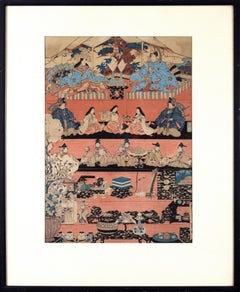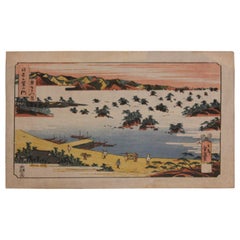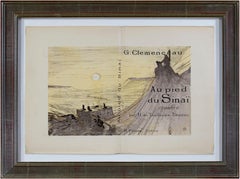Utagawa Toyokuni Landscape Prints
Japanese, 1769-1825
Utagawa Toyokuni[a] (歌川 豊国; 1769 – 24 February 1825), also often referred to as Toyokuni I, to distinguish him from the members of his school who took over his gō (art-name) after he died, was a great master of ukiyo-e, known in particular for his kabuki actor prints. He was the second head of the renowned Utagawa school of Japanese woodblock artists, and was the artist who elevated it to the position of great fame and power it occupied for the rest of the nineteenth century.
He was born, the son of Kurahashi Gorobei, a carver of dolls and puppets, including replicas of kabuki actors.
At around 14, Toyokuni was apprenticed to the first head of the Utagawa house, Utagawa Toyoharu, whom his father knew well and who lived nearby.
One of his fellow pupils under Toyoharu was Toyohiro, whose pupil was the great landscape artist Hiroshige. In recognition of his artistic ability, Toyokuni later took the name Utagawa Toyokuni, following the common practice of using one syllable of his master's name.
Toyokuni seems not to have been an "intuitive genius"determined to forge a new path; rather, he seems to have studied intently those who came before him, particularly Utamaro, Chōbunsai Eishi and Eishōsai Chōki and through a great deal of hard work produced first a mastery, and then a synthesis of their styles, to create a style of his own.
He was known mostly for his prints related to the kabuki theatre, in particular his yakusha-e actor portraits, a field which he took to new heights. He also, however, produced other genres such as musha-e warrior prints, shunga erotica, and most notably bijin-ga.
In his actor prints, like Sharaku, one sees the real subject; but his prints merely portrayed what he saw, unlike Sharaku who exaggerated those aspects he saw as the most key. It is said of Toyokuni's prints that they recreate exactly what one would see on stage; they show actors acting, not merely just pictures of actors.
Together, these characteristics made Toyokuni's prints far more popular among theatre-goers than Sharaku's, although history has come to judge Sharaku the keener observer and greater artist.
His popularity and prolific output may in part have been his undoing, though. From 1803 through 1817, his work became more static, even as it became more popular. He continued to produce large quantities of prints, but the quality as a rule did not match that of his earlier days. Occasional prints from this period, however, show his old brillianceto
1
Overall Width
to
Overall Height
to
11
180
169
142
131
1
1
1
1
1
1
1
1
1
1
1
1
1
1
Artist: Utagawa Toyokuni
"Various Himochi" Wagashi Festival Japanese Woodblock Print by Utagawa Toyokuni
By Utagawa Toyokuni
Located in Soquel, CA
"Various Himochi" Wagashi Festival Japanese Woodblock Print by Utagawa Toyokuni
Rare oversized early 19th century 5-tiered woodblock by Utagawa Ichiyosai Toyokuni, (Japan, 1769-1825), a Japanese lord and wife oversee a sekku festival of food, music, and dolls or toys. '"oshi" is the first day of “Mi (Snake)” in the third month of the lunar calendar. This day, known in modern Japan as the Girls' Festival, originated in China as a form of purification ceremony in which water and drinking peach blossom wine were used to drive away evil. Many kinds of hishi-mochi appear in this picture of hina ningyo (dolls associated with Hinamatsuri, or the Girl’s Day) from Omochae.
The custom of eating special dishes at events throughout the year and at milestones in people's lives has existed since ancient times. This paragraph specifically focuses on the annual event called sekku, and life events that involve eating sweets. Joshi is the first day of “Mi (Snake)” in the third month of the lunar calendar. This day, known in modern Japan as the Girls' Festival, originated in China as a form of purification ceremony in which water and drinking peach blossom wine were used to drive away evil. According to the Keiso saijiki, in ancient China, on the third day of the third lunar month, people ate “ryuzetsuhan,” which is the juice of gogyo (Jersey cudweed) mixed with rice flour and nectar. In Japan, there is a record in the Heian period history book Nihon Montoku tenno jitsuroku [839-5] that it was an annual event to make kusamochi using gogyo on the third day of the third month of the lunar calendar, which may have been influenced by Chinese customs.
The tradition of eating kusamochi on the third day of the third month of the lunar calendar continued after that. By the Edo period, however, hishimochi had come to be used as a sweet to serve on the third day of the third month. A picture of a hishimochi is included in the Morisada manko , which we mentioned in Part 1. According to it, hishimochi in the Edo period were often three layers of green-white-green instead of the now common red-white-green. However, it is possible to see from our collection that not all hishimochi were made in this way. Omochae published in 1857, is a good example. Omochae is a type of ukiyoe print...
Category
1820s Edo Utagawa Toyokuni Landscape Prints
Materials
Ink, Rice Paper, Woodcut
Related Items
Edo Landscape Japanese Woodblock Print
By Utagawa Hiroshige (Ando Hiroshige)
Located in Houston, TX
Edo Meisho woodblock print of a famous Japanese coastal dock. This woodblock is most likely apart of the series "One Hundred Famous Views of Edo." The woodblock print is printed on r...
Category
1850s Edo Utagawa Toyokuni Landscape Prints
Materials
Woodcut
$1,500
H 10 in W 15 in D 0.004 in
Toulouse Lautrec Original Lithograph Famous Political 1800s Collection Signed
By Henri de Toulouse-Lautrec
Located in Milwaukee, WI
"Lautrec Book: From Au Pied du Sinai written by Georges Clemenceau" lithographs created by the legendary Henri de Toulouse-Lautrec. This book, Au Pied...
Category
1890s Post-Impressionist Utagawa Toyokuni Landscape Prints
Materials
Mulberry Paper, Lithograph
12 images on 6 sheets from Nuova raccolta delle vedute moderne di Roma
Located in Middletown, NY
Rome: 1795.
Each an engraving with extensive hand coloring on laid paper, some with a partial heraldic watermark, each 6 5/8 x 4 3/4 inches (165 x 120 mm); (sheet) 10 1/4 x 7 1/8 in...
Category
Late 18th Century Italian School Utagawa Toyokuni Landscape Prints
Materials
Ink, Handmade Paper
Tugs on the Hudson
By Charles Frederick William Mielatz
Located in Middletown, NY
Drypoint etching with engraving printed in black ink on Japanese mulberry paper, 4 1/2 x 3 3/8 inches (113 x 84 mm), full margins. In superb condition. A beautiful New York City river...
Category
Early 20th Century American Modern Utagawa Toyokuni Landscape Prints
Materials
Handmade Paper, Drypoint, Etching
Ôkubo Hikozaemon Protects the Hidden Shogun Triptych
By Taiso Yoshitoshi
Located in Burbank, CA
“War Chronicles of Osaka” (Osaka gunki no uchi). Okubo Hikozaemon, raising his sword, protects the hidden Tokugawa shogun from the spear of Gorô Matabei Mototsugu in a moonlit fores...
Category
1880s Other Art Style Utagawa Toyokuni Landscape Prints
Materials
Mulberry Paper, Woodcut
$4,975
H 14.69 in W 29.14 in
KCHO (Alexis Leyva Machado), ¨Untitled II¨, 2019, Woodcut, 44.7x31.1 in
By KCHO (Alexis Leyva Machado)
Located in Miami, FL
Alexis Kcho Leiva (Cuba, 1970)
'Untitled II', 2019
woodcut, silkscreen on paper Intaglio 300 g.
44.7 x 31.2 in. (113.5 x 79 cm.)
Edition of 30
ID: KCH-120
Unframed
Category
2010s Contemporary Utagawa Toyokuni Landscape Prints
Materials
Paper, Woodcut, Ink
Toshogu Shrine
Located in Middletown, NY
In image of the Tokugawa family paying homage to Tosho-gu Shrine in Nikko.
Tokyo: Matsuki Heikichi, 1896
Woodcut in ink with embossing and hand-coloring in watercolor on handmade m...
Category
Late 19th Century Edo Utagawa Toyokuni Landscape Prints
Materials
Watercolor, Handmade Paper, Woodcut
"Dawn Inside the Yoshiwara" Utagawa Hiroshige, Japanese Landscape, Ukiyo-e
By Utagawa Hiroshige
Located in New York, NY
Utagawa Hiroshige
Dawn Inside the Yoshiwara, circa 1857
Woodblock print
11 x 7 inches
Utagawa Hiroshige is recognized as a master of the ukiyo-e woodblock printing tradition, havin...
Category
1850s Naturalistic Utagawa Toyokuni Landscape Prints
Materials
Paper, Ink, Woodcut
The Battle of Dan-no-ura in Yashima, Nagato Province in the First Year .....
By Utagawa Yoshitora
Located in Middletown, NY
The Battle of Dan-no-ura in Yashima, Nagato Province in the First Year of the Bunji Era (1185)
Tokyo c. 1830
Woodblock print (nishiki-e) with ink and hand-coloring in watercolor on handmade mulberry paper, 14 7/16 x 9 15/16 inches (367 x 252 mm), ōban tate-e, the full sheet. In good condition with some handling creases. Colors are fresh and extremely vibrant. The right panel from the triptych by Yoshitora depicting one of Japan's most storied naval battles. An impression of this work may be found in the permanent collection of the Honolulu Museum of Art.
The great naval battle of Dan-no-ura in 1185 was the final climax in a long series of bitter wars between two powerful families in feudal Japan...
Category
Early 19th Century Edo Utagawa Toyokuni Landscape Prints
Materials
Watercolor, Handmade Paper, Woodcut
$1,500
H 14.44 in W 9.94 in
Venus Lamenting over the Death of Adonis
By Herman van Swanevelt
Located in Middletown, NY
c. 1654. Etching with engraving on thin laid paper with an early and large unidentified watermark with a sundial and a many-pointed star, and an unidentified collector's stamp in the...
Category
Mid-17th Century Old Masters Utagawa Toyokuni Landscape Prints
Materials
Handmade Paper, Engraving, Etching
KCHO (Alexis Leyva Machado), ¨Untitled (Triptych)¨, 2019, Woodcut, 44.7x93.3 in
By KCHO (Alexis Leyva Machado)
Located in Miami, FL
Alexis Kcho Leiva (Cuba, 1970)
'Untitled (Triptych)', 2019
woodcut on paper Velin Arches 300 g.
44.7 x 93.4 in. (113.5 x 237 cm.)
Edition of 30
ID: KCH-118
Unframed
Category
2010s Contemporary Utagawa Toyokuni Landscape Prints
Materials
Paper, Woodcut, Ink
Beauties on the Beach with view of Mount Fuji
By Yoshu Chikanobu
Located in Burbank, CA
Shichirigahama, Sagami Province. A beauty in the foreground waves to her young companions, who run towards her on the beach. The beauty at left wears a western-style golden ring. We ...
Category
1890s Edo Utagawa Toyokuni Landscape Prints
Materials
Handmade Paper, Mulberry Paper, Woodcut
Previously Available Items
Ichikawa Danjuro VII
By Utagawa Toyokuni
Located in Austin, TX
Artist: Utagawa Toyokuni I
Title: Ichikawa Danjuro VII
Medium: Color woodblock print
Origin: Japan
Date: 1786
Dimensions: 8.5 inches height x 7.5 in width
T...
Category
Late 18th Century Edo Utagawa Toyokuni Landscape Prints
Materials
Woodcut
Utagawa Toyokuni landscape prints for sale on 1stDibs.
Find a wide variety of authentic Utagawa Toyokuni landscape prints available for sale on 1stDibs. You can also browse by medium to find art by Utagawa Toyokuni in handmade paper, ink, paper and more. Not every interior allows for large Utagawa Toyokuni landscape prints, so small editions measuring 22 inches across are available. Customers who are interested in this artist might also find the work of and Utagawa Hiroshige (Ando Hiroshige). Utagawa Toyokuni landscape prints prices can differ depending upon medium, time period and other attributes. On 1stDibs, the price for these items starts at $1,480 and tops out at $1,480, while the average work can sell for $1,480.



